
N
JOURNAL of
EDUCATI
November 2022 VIRGINIA
Is Seamless Technology Integration the Missing Piece in Your Classroom?
ideas on
it
for you and your students.
The magazine of the Virginia Education Association
Some
making
happen
VEA President
Dr. James J. Fedderman
VEA Executive Director
Dr. Brenda Pike
Communications Director
Kevin J. Rogers
Graphic Designer Lisa Sale
Editorial Assistant/Advertising Representative

Kate O’Grady
Contributors
Katie Seidemann Jennifer Naperala
Patrick Hausammann Bruce Ingram
Debbie Tannenbaum
Nathan Sekinger
UPFRONT
Vol. 116, No.2
Copyright © 2022 by the Virginia Education Association
The Virginia Journal of Education (ISSN 0270-837X) is published six times a year (October, November, December, February, April and June) by the Virginia Education Association, 116 South Third Street, Richmond, VA 23219.
Non-member annual subscription rate: $10 ($15 outside the U.S. and Canada). Rights to reproduce any article or portion thereof may be granted upon request to the editor. Periodicals postage paid in Richmond, VA.
Postmaster: Send address changes to Virginia Journal of Education, 116 South Third Street, Richmond, VA 23219.
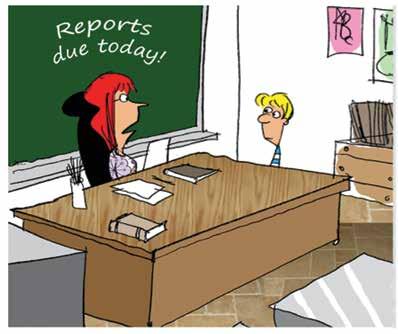

Article proposals, comments or questions may be sent to the editor at tallen@veanea.org or Tom Allen,116 South Third Street, Richmond, VA 23219, 800-552-9554.



Member: State Education Association Communicators
DEPARTMENTS
VEA Vision:
VEA Mission: The mission of the Virginia Education Association is to unite our members and local communities across the Commonwealth in fulfilling the promise of a high quality public education that successfully prepares every single student to realize his or her full potential. We believe this can be accomplished by advocating for students, education profession als, and support professionals.
Editor
Tom Allen
CONTENTS
technology integration seamless in your classroom. 8 FEATURES 13 Before You Pull the Lever What you need to know as you prepare to vote this November. 14 The Truth about School Libraries Besmirched by some these days, here’s what libraries in schools are really up to. 18 Educators Must Stand Together A
collective bargaining
COVER STORY Making
Chesapeake teacher explains why unity and
benefit everyone.
20 Membership Matters VEA members
EPIC
24 Insight
Instruction Discussion
30 First
gather for
event.
on
prompts for teachers.
Person What being the ‘dumbest kid in the class’ taught me.
have
Taco Tuesday,
I
with
Tuesday…”
4-7 This month: Hope, sleepy teenagers, and Touching Base With Montgomery County’s Katie Seidemann. Cover and above photo by iStock. “I
heard of
but
can’t say I’m familiar
No-Test
A great public school for every child in the Commonwealth of Virginia.
Scott
“Huh. I did not see that coming.”
For Some Sleepy Teens, It’s Not Adding Up
The first thing to under stand is the amount of sleep teens need is 8 to 10 hours. Eight is the minimum recommended amount. We look at our teens and often they’ll look like adults, but they’re not, they do need more sleep.


The other thing to recognize about teen’s sleep is that their sleep schedules are different. They have essentially a different body clock that is governing when they want to fall asleep and when they want to wake up in the morning. So it’s a circadian rhythm shift, which means that unlike when they were younger, they really aren’t sleepy and ready to fall asleep until close to about 11 o’clock at night. So, that means when you do the math…if they are supposed to be sitting in their desks for a 7:30 a.m. morning bell at school, there’s no way they can be getting the 8 to 10 hours of sleep that they need.l



— Lisa Lewis, former education journalist now advocating for later school start times
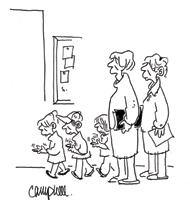
Spotted on Twitter
Um, What I Meant to Say Was…
Student bloopers, from Anguished English: An Anthology of Accidental Assaults upon Our Language:
“Abstinence is a good thing if practiced in moderation.”
“When you breathe, you inspire. When you do not breathe, you expire.”
“The death of Francis Macomber was a turning point in his life.”
“Rural life is lived mostly in the country.”
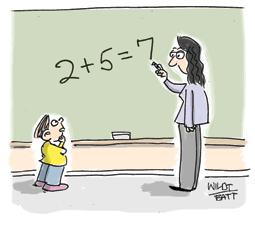
“To be a good nurse, you must be absolutely sterile.”
“The President of the United States, in having foreign affairs, has to have the consent of the Senate.”
“I expected to enjoy the film, but that was before I saw it.”
“A triangle which has an angle of 135 degrees is called an obscene triangle.”l
TOUCHING
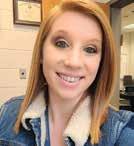
BASE WITH…
KATIE SEIDEMANN
MONTGOMERY COUNTY EDUCATION ASSOCIATION Choir teacher
What do you like about your job?
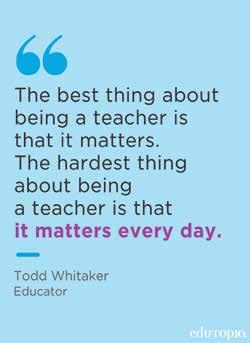
I absolutely love being a choir teach er. Music classes are one of those few, special places where students are given permission to explore their creativity, to experiment with their comfort zone, to develop their individuality, and to practice kindness and empathy. Choir truly does feel like a supportive team atmosphere where mistakes are encouraged, silliness is expected, and everyone wants everyone to succeed.
1 in 4
How has being in the Union helped you? Joining the MCEA was one of the best decisions could have made as a young teacher. My fellow members are the smart est, kindest, and fiercest advocates for both their students and their colleagues. The MCEA has given me a place in which I can find an ear to listen, a shoulder to cry on, and a boost up whenever need it—sometimes all in the same day! MCEA members have helped me to better under stand the systems at play in and outside of our schools, to better advocate for the rights of our employees, and to better un derstand my worth as a teacher. No matter the issue, if I’m not sure where to go, I go to my MCEA. #iamtheMCEA l
4 VIRGINIA JOURNAL OF EDUCATION | NOVEMBER 2022 VIRGINIA JOURNAL OF EDUCATION NOVEMBER 2022 5 UP FRONT
“I think I’ll stop teaching them that primates are superior because they have opposable thumbs.”
Photo and illustrations by iStock
U.S. public schools that lack classroom doors that can be locked from the inside
Source: National Center for Education Statistics
Public vs. Private ‘Fast Fact’
According to its most recent data, the U.S. De partment of Education says that 59 percent of teachers in traditional public schools have earned a post-un dergraduate degree (including a master’s degree, an education specialist degree or certificate, and a doctorate degree). In U.S. private schools, that percentage is 48.l


Public Has Our Backs, if Not Our Career Aspirations
You’d have to go back 48 years in the annual PDK Poll of the Public’s Attitudes Toward the Public Schools to top how Americans rate their local public schools today. In 2022 results, 54 percent of adults gave their community’s schools an A or B. That’s a jump of 10 points since the question was last asked in 2019. The previous high was 53, set in 2013; the long-term poll average is 44 percent.
That doesn’t, however, translate into encouraging children to pursue a career in the classroom. Only 37 percent of adults in this year’s survey would want their child to be a public school teacher, compared with a poll-high positive response of 75 percent in 1969 and a longterm average of 60 percent.l
Not ‘Fake News’ at All



From an editorial in the (Fredericksburg) Free Lance-Star: Teaching is, and always will be, an art. The path to improved student achievement doesn’t run through more standard ized tests and mindless rote memorization. Rather, students’ success is directly tied to a teacher’s imagination. To those who never have stood before a classroom, it can be hard to understand why this is so…

[Teachers] can set high standards that are suitable for each student’s ability level. They can modify lessons when necessary to meet individual needs, to incorporate the skills each student brings to strengthen the classroom and to find a way for each student to have some success every day…


The Hope We All Have
I have hope in the millions of students that are courageous and bright and that will create a better world.


I have hope in the millions of educators who provide love and normalcy to an unkind world.
I have hope in the transformative power of education that can move the needle towards equity and justice. This isn’t just my message of healing and prosperity; it’s our work together because we are a profession that understands the importance of potential and hope—the potential in our students, schools, and communities.l
— 2022 National Teacher of the Year Kurt Russell, an Ohio high school history teacher
“Wow! These people actually did stuff instead of just posting on social media!”
These Numbers Don’t Work…
1.7 million students are in schools with police but no counselors.
3 million students are in schools with police but no nurses.
6 million students are in schools with police but no school psychologists.
10 million students are in schools with police but no social workers.
“This next number goes out to all those talented, hard-working, underpaid teachers who’ll be grading our tests tomorrow.”

Teachers are the most critical individuals outside of immediate family members to helping young adults reach beyond their limited reality and into the broader world.l
14 million students are in schools with police but no counselor, nurse, psychologist, or social worker.l
Source: ACLU
6 VIRGINIA JOURNAL OF EDUCATION | NOVEMBER 2022 VIRGINIA JOURNAL OF EDUCATION | NOVEMBER 2022 7 UP FRONT Photo illustrations by iStock
means trying to make technology a seamless part of your classroom. It’s not an add-on offered when time allows or because it’s mandated. It’s a process through the year of building technology uses and skills for both students and teachers. It doesn’t even mean that technology is always used; instead, it means that technology is known and avail able to be used when it fits, when it extends a lesson, when it offers opportunities or options that don’t exist without it—in short, when it enhances a learning experience. Technology is not a silver bul let, replacement for a great teacher, or even always the best option. But it can be an outstanding tool in an educator’s repertoire.
Here are six reasons why:
1. Technology redefines what’s possible in the classroom by creating new options.
2. Technology can be an excellent way to make content accessi ble to all, such as facilitating Universal Design for Learning principles.

5. Eliminating double-teaching increases creativity and agency. When students aren’t having to learn two things at the same time, they’re free to think creatively with technology versus just about how to use it. Often, the most creative uses of technology come during exploration of deeper possibilities possible when one already knows the basics.
6. You’re not just meeting digital natives where they are but helping those who have never known a world without Google learn and show mastery (create) with technology they’re passionate about. The shift from consumer to creator may be one of, if not the, most important reason to inte grate versus just “use” technology in your classroom. Creating pushes students into higher levels of both knowledge acquisition and reten tion than does the more passive act of consuming information.

HOW TECHNOLOGY INTEGRATION MIGHT LOOK
Is Seamless Technology
Have you ever been told to integrate technology into your classroom, to make it a key part of your instruction, but didn’t know how or where to start? The prospect of new technology can feel so overwhelming: There are so many options, and it can seem like just something else added to your plate after two rollercoaster years.
In our respective roles as a Supervisor of Instructional Technology and as a Technol ogy Coach, both Patrick and I understand these challenges. In this article, we’d like to help you find some of the magic that technology can create in your classroom and share a few gems we think will make a big difference for you and your students.
By Patrick Hausammann and Debbie Tannenbaum
While the term “technology integra tion” can sound intimidating, it really only
3. It allows us to better prepare our students for the future- 4 C’s; Critical Thinking, Collab oration, Communication, & Creative Thinking (or 5 C’s if you add Citizenship).
4. When technology is integrat ed, the need to teach both technologies and the content (double-teaching) is removed. The technological knowledge is already there, built throughout the year, and before long only teaching of content remains. Often, students are quickly able to assist with technology during lessons, building in another support for teachers.
In Math: Students are beginning a new unit and you’d like to see what they already know about concepts such as transla tions or money. To demonstrate this, they log onto Desmos and use a poly graph activity. During this activity, stu dents work with a partner (either as an anonymous or known partner) as they play this math version of Guess Who. One student selects a card; then anoth er asks math questions to determine which card it is. Students get a chance to work with multiple classmates and the teacher can collect data on their understanding based on the questions asked. Later in the unit, this could also be used as a formative assessment to see progress made.
In English/Language Arts: When students arrive, they know that Google Classroom is always the first place to check. There they find an entrance ticket activity to use Flipgrid, Google Docs, or Google Canvas to reflect on everything they learned the day before, as well as to pose any questions about what they didn’t understand. Before the day’s lesson begins, students have 3 minutes to connect with a peer and co-reflect to try to answer the questions on the entrance ticket. The whole class discusses briefly, then the new lesson begins with students utilizing a digital inter active notebook to take notes during direct instruction. For the latter part of the block, students divide up into groups they’ve been in to work on a project to craft persuasive arguments for a cause of their choice. They re search using databases from the library, Google Scholar, and more, and work together, both verbally and virtually, via their collabo rative medium of choice (Docs, Flipgrid, Google Classroom, etc.).
Class wraps up for that day with students turning in a draft of their projects (essays, podcasts, art creations, videos, etc.).
COVER STORY
Piece
Your Classroom?
Integration the Missing
in
Photo illustration and photo by
iStock
Some ideas on making it happen for you and your students.
JOURNAL OF EDUCATION | NOVEMBER 2022 9
VIRGINIA
In Science:
While studying the solar system, students can get a better grasp on the relative size of the planets’ orbits by using a Gizmo, an online simu lation, which will show them the length of time each planet’s orbit takes. Rather than just reading about this, students collect data and use their research to draw their own con clusions. Moreover, this Gizmo, like the others on the ExploreLearning site, are aligned to state standards, making the integration seamless.
In History:
Students begin a collaborative brainstorming session with Google Jamboard and Docs, responding to your prompt to work with a part ner or in a group to become a tour guide to one place or person they’ve studied this year (or will study). They collaborate and communicate, both
in-person and virtually, using these tools alongside video conferencing and/or asynchronous video with Flipgrid. Throughout classes, they add notes to their information as lessons continue and questions are answered in direct instruction, video, and class work. Storyboard That or grid mode of Google Slides is used to map out their final products (presentations, videos, flying tours in Google Earth, or a teacher approved medium). In every element of the ongoing work, students choose the technology components or offline mediums that align to their skills and passions. The teacher provides both tutorials for the technology and time for support as needed. Wherever possible, students become the teacher to demonstrate tools for the class and support each other.
In Electives/Specials:
The art teacher has learned from the math team that students will be studying geometric shapes, so to help reinforce those concepts, students will be finding, creating, and show casing geometric art. The students get information on the project that will be worked on both verbally and within their LMS (for later checks). Any students without a camera-enabled device are provided one. The class then makes their way outside to take a walking tour of the area surround ing the school to capture as many shots as possible of geometric shapes. These will serve as part of the inspi rational part of their digital portfolios (websites). After half the block out side, students return to the classroom to upload their images to the cloud for safe storage and begin researching online images of geometric shapes both in real life and in still art. The block concludes with students reflecting on their progress through out the period and using this to outline the next steps in building their showcase (plan ning their creation). They’ll later present their creations to the class live or through video, with peers using electronic peer reviews to provide non-evaluative feedback. We’ve included a list of resources to help you
strengthen your technology knowl edge and skills in “Resources for Your Toolkit” on page to the right.
TEN TIPS YOU CAN USE TO MAKE A DIFFERENCE WITH TECHNOLOGY
1. Start with your learning objectives first (never start with technology).
2. Don’t use technology just for the sake of using technology.
3. Consider how the technology tool will enhance or amplify student learning.
4. Take time to teach your students how to navigate the programs you choose. Teach icons to help facilitate this. Consider starting this early in the year to build relationships while learning the technology.
5. Find tools that can be used for multiple content areas and ages or throughout your class/course. Many tools are multifaceted and can lend themselves to integra tion throughout a class instead of just being used once in a while.
6. Give students opportunities to engage in the 5 C’s using tech nology.
7. Use technology to enhance the Universal Design for Learning principles in your classroom. Let technology help you reach all students.
Resources for Your Toolkit
Blogs We Recommend
• Tannenbaum Tech (tannenbaumtech.com/blog)
• UnisonEDU (unisonedu.org/blog)
• Tech You Can Do (techyoucando.com)
• Control Alt Achieve (controlaltachieve.com)
• Ditch That Textbook (ditchthattextbook.com)
• EfficienTEACH (ditchthattextbook.com/efficienteach)
• Shake Up Learning (shakeuplearning.com)
Lesson Repositories
• #GoOpenVA (goopenva.org)
• Virtual Virginia (virginiavirtual.org)
• Adobe Learning Exchange (edex.adobe.com)
• EducationBlueprint.org
• PBS Learning Media (vpm.pbslearningmedia.org)
• Verizon Innovative Learning (verizon.com/learning)
• Khan Academy (khanacademy.org)
• National Geographic (nationalgeographic.org/society/ education-resources)
• NCTM Illuminations (illuminations.nctm.org)
• EDSITEment (humanities) edsitement.neh.gov/lesson-plans
• Stanford History Education Group (sheg.stanford.edu)
• Share My Lesson (sharemylesson.com)
• Templates for Teachers (templatesforteachers.com)
• We Are Teachers (weareteachers.com/free-teacher-resources)l
8. Learn alongside your students by allowing them to support/teach both you and classmates.
10 VIRGINIA JOURNAL OF EDUCATION | NOVEMBER 2022 VIRGINIA JOURNAL OF EDUCATION | NOVEMBER 2022 11
Photo by iStock COVER STORY
Patrick Hausammann Presentations
• A 6-Pack of Tools That Can Transform Your Classroom and Student Engagement (bit.ly/ phaus-6pack)
• Student Drive Performance Based Assessment (bit.ly/ sdpba18)
• All The Things You Didn’t Know Google Slides Could Do! (bit. ly/phaus-gslidest)
• 5 Great Ways to Structure Student Led Learning (bit.ly/ phaus-5gw)

• Amazing Tech Tools for Stu dent Creation and Innovation (bit.ly/30att)
• Magic Beneath the Surface of EdTech (bit.ly/phaus-mbtsoe)
• Bring the World to Your Class room with Google Geo Tools (bit.ly/phaus-ggeo)l
9. Don’t be afraid to ask for help. Utilize both your in-school/ district professional learning network as well as a virtual one to always have support and collaborators.
10. Start small and strategic; little steps add up. Your path is unique to you and your students. Don’t measure yourself against the triumphs of others. Measure your success by the triumphs within yourself and in your classroom. Grow and build from both successes and failures; both are strong teachers.
CONCLUSION
In the end, every educator’s technolo gy integration journey is as individual as their path was to making their career choice. Many of us were forced to use technology to excess during the COVID-19 pandemic. Let’s move past that and shift our focus to the aspects of technology integration that were enhanced during the pandemic. Many more teachers and students know the basics of technology than ever before, and have moved to high
er levels of communication and collaboration. Do away with the forced use of technology and, instead, embrace its integra tion to provide students with opportunities and access they’ve never had before. Embrace your PLN to support you along the way and use what you learn to help others. We’re always happy to help any educators that reach out. Let’s collaborate and always share the amazing opportunities we can create for our students!l
Patrick Hausammann, a member of the Clarke County Education Association, is the county’s Supervisor of Instructional Technology and an ITRT at Boyce Elementary School and JohnsonWilliams Middle School. Debbie Tannenbaum is a school-based Technology Specialist, consultant, and blogger.
Before You Pull
the Lever
As Election Day 2022 nears, a quick question, and it’s not the gimme that you might think. There are federal elections this year: Do you know who your U.S. House of Representatives member is?
and proposal on your ballot.
Who are Educators Backing?
What you need to know as you prepare to vote this November.
You may think you do, but the long-simmering dispute about gerrymandering and Congressional and General Assembly redistricting in our state was resolved by the Virginia Supreme Court late last year— and the re sulting changes affected more than 8,000 of VEA’s members. Maybe even you. To be certain you know who you’ll be casting your vote for, check the Virginia Public Access Project’s website: vpap.org/ redistricting, where you’ll find the official district maps. You were not required to change or renew your voter reg istration after the new maps were drawn, but you should confirm your polling place by checking the Virginia Department of Elections site here: vote.elections.virginia.gov/ VoterInformation. Election Day is Tuesday, November 8, and polls are open from 6 a.m. to 7 p.m.
Check the Lineup
You can find out who’s running for federal and local offices in your area, as well as check to see if there are any local measures up for a vote by visiting the site of the nonpar tisan organization Ballot Ready at ballotready.org. There, you’ll find information about every candidate
The VEA Fund for Children and Pub lic Education, our Union’s political action committee, doesn’t make recommendations in federal elec tions, but the National Education Association Fund for Children and Public Education does. To find out if the NEA Fund has recommended anyone in your Congressional elec tion this fall, go to educationvotes. nea.org and click Recommended Candidates.
VEA Members Making the Race
If you’re an educator in the Tide water area, you’ve got several special reasons to pay attention to local races. Three VEA members are in the running, one each from Chesapeake, Portsmouth, and Norfolk. VEA-Retired member Malia Huddle, who worked as a teacher and counselor for more than 30 years in Chesapeake, is running for one of five open spots on the city’s school board. Carly West Gelles, a Portsmouth Education Association member and a high school English teacher, is a school board candidate in Norfolk. Also in Norfolk, former Education Association of Norfolk president Phillip Hawkins is running for a city council seat.
How You Can Help
It’s not too late! You can play a vital role in getting pro-public education candidates elected by helping with “Get Out the Vote” efforts or vol unteering to assist in a candidate’s campaign. You can find a listing of upcoming volunteer opportunities at mobilize.us/vea l
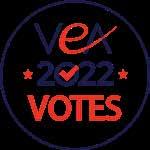
12 VIRGINIA JOURNAL OF EDUCATION | NOVEMBER 2022 VIRGINIA JOURNAL OF EDUCATION | NOVEMBER 2022 13 COVER STORY
FEATURE STORY
Photo and illustration by iStock
The Truth about School Libraries

Besmirched by some these days, here’s what libraries in schools are really up to.

 By Nathan Sekinger
By Nathan Sekinger
What really goes on in school libraries? If you’ve been checking the news lately, you might think they’re hotbeds of controversy. The truth is that a school library is both a refuge and a resource, and an amazing one can be the heart of a school. It can be the connection between reading literature and meeting a favorite author. It can join a scientific concept to a makerspace for deeper explo ration. And it’s a space where learning can be infused with choice and identity.
When I meet my newest middle school students each year, I’m sure to tell them that the library is a shared space for all of us, one that’s even better when we all add our ideas and voices to it. In fact, it really only works when we all add something. And the best libraries are the ones that try to include as many voices as possible. Each library should be a reflection of its school community: its students, families and staff. It’s a vision meant to reflect and inspire our community, where the challenges of our past inform the ideas needed to meet our future ambitions.
What does that look like? How does that vision look in the real world? The library should have room for student voices. There is student art displayed on the walls, ways for students to review books or provide recommendations, and students designing and leading programming. Students should be leaders in the library, taking ownership over the plac es where they find their identity. The library must also be a safe space. From inclusive policies and signage to Zen zones and comfy furniture, a library can be a physical and emotional com fort for our community. Through its re sources and displays, a library can tell its community that it values and embraces their identity, even as it is still developing. And the library can be a place of joy. Special events, food, and service programs can offer opportunities to build connections, to try something new and be a part of something important. This means that, as a school librarian, in addition to being an enthusiastic man ager for this ever-changing madness, I recognize the awesome opportunity I have to curate not just the books on the shelves, but to be a steward to the space itself. Retired Ohio State profes sor Rudine Sims Bishop, a pioneer in studying children’s literature, calls this providing “the mirrors, windows, and sliding glass doors” that our communi ty desperately needs. While this pivotal idea originally pertained to literature, it is equally applicable to the library as a place, not just the books on its shelves. That means that the library is a mirror, a place of reflection and self-affirma
tion for students, allowing our com munity comfort and sanctuary in the space. The library is a window, a place of imagination that allows someone to see far outside of their circum stances into a thrilling world beyond. And this window, in the library, can become a gateway for students to learn and discover something new, or even better, to imagine themselves as something new. This is the sliding glass door that a library can become, transporting our students into smarter, more thoughtful and kinder versions of themselves. That is the magic of a successful school library and it begins with a school librarian.
make excellent collaborators. I don’t teach just what think is important to students, but plan content in context with what is happening in a teacher’s classroom. The right lesson has to occur at the right time. This requires understanding the students and curriculum with each group and teacher that I work with. As an infor mation specialist, I work to find the best resources for students and staff, providing a robust understanding of research processes and ensuring that our methodology allows for a diversity of opinions and resources. From reading to robots, gardening to geeking out, our library offers a
The Virginia Association of School Librarians (VAASL) says it this way: “School librarians are certified teachers, instructional partners, infor mation specialists, program adminis trators, and leaders who are essential to student success.” We’re taught that a successful librarian weaves all these roles together throughout the year. Librarians are teachers. Last school year, I taught over 700 lessons in more than 25 content areas, reaching all students in my school. To do this well meant working as an instruction al partner with teachers. Librarians
plethora of programs to try to cap ture the interest and attention of our nearly 1,000 students. We may start the week with video games design and microcontrollers, only to follow it with cosplay costume making and end with hosting manga fans for a reading trivia challenge. As a pro gram administrator, I balance cost and value, manage a budget, recruit student managers, and always look for ways to inspire my students and connect them to literature, the library and each other. And finally, as a leader, I understand the
The Virginia Public Education CoalitionTheT FEATURE STORY Photos and Illustration by iStock VIRGINIA JOURNAL OF EDUCATION | NOVEMBER 2022 15
challenges of being the only one in a building. Advocacy becomes a necessity, as vital as oxygen. I truly believe that students need and deserve the best possible education they can get, so that means their li brary needs resources, opportunities and partnerships.
Partnerships are vital School librarian leaders need partners to make their libraries the amazing places they should, could and deserve to be. Everything I know about how to be a successful librar ian comes from others, including my librarian colleagues in my school division. I am the only librarian at my school, but with a full-time library as sistant, the two of us work as a team to support the many roles of a school librarian. We want the library to be open always for check out, research and student exploration, while also allowing time for collaborative plan ning and teaching, as well as strate gic planning and implementation of ongoing programs. This is more than a full-time job for two people.
Partnership extends to the teachers in my school; I rely on them to be the experts of their content and their students, while I try to infuse the library’s role, resources and my own professional knowledge as a teacher into the projects we design together. It could be a single lesson for one class or an entire unit for a whole grade level. Beyond classroom teachers, the library’s role extends to finding collaborative partners among our administration, families, business es, building maintenance, and food services. Planning conversations with the head of our food services was in strumental in blending remote library services with food pick-up during the pandemic. Families found access to books at all levels and a hot meal. When a library seeks to be the heart of a school, it must make extensive connections through all parts of its community. also rely on partnerships beyond our school and community to increase my effectiveness as a librarian and educator. I joined the VAASL shortly after transitioning from being a high school and college level
English teacher to becoming a middle school librarian. I found colleagues from across the state interested in learning and sharing with each other. They faced similar challenges and developed expertise in areas that I was interested in, developing valu able programs for students, growing a school makerspace, and using best practices in teaching research skills. They were also an amazing support as I pursued my National Board Certifica tion, and I was eager to celebrate with VAASL when I became a NBCT in 2013.
As I expanded my skills, I was invited to present at conferences and was eventually selected by VAASL as their 2017 School Librarian of the Year. Soon after, served as the Director of the Rappahannock Region and starting in November, I will serve as the President of the organization. What I understand now about the organization is that a member serves the group, while the group serves the member.
This past school year has been a prime example of how individuals might need the support of a strong organization. As a librarian and an educator, I have been privileged to be a
member of both VAASL and VEA. With the wave of misguided book banning sweeping across our country, my educator colleagues might share my opinion that this is part of a broader movement that distrusts educators, willfully misunderstands our curricu lum, and seeks to score political points rather than support our students. This movement might be a political fad, but it will have lasting effects by discouraging educators and demor alizing the students we support. And while we can attempt to challenge this movement in our individual classrooms and libraries, it is only by rallying large groups of fellow educa tors and our larger communities that we can begin to respond to this vocal minority.
Taking a stand
Last fall, in our neighboring county of Spotsylvania, a few comments of con cern about a book from a parent led to a dramatic reaction among school board members, including stating that questionable books should be “thrown [...] on a fire.” It was also suggested that entire school libraries must be closed so that librarians could audit their collections for question able content, rather than following their own established policies for considering a challenged book. Both VAASL and VEA members sprang into action. I was overwhelmed when I attended the a Spotsylvania school board meeting last November to hear from dozens of parents, students and librarians about the power of litera ture, the personal impact that read ing had on them,

their shock at the school board for not following the established county policy to handle a concern about a book, and their revulsion at the idea that clearly biased individuals on the school board would make choices for all students about what books were appropriate for a school library. My VAASL colleague and friend, librar ian Kim Allen, spoke eloquently at the meeting, challenging the school board with these words: “Librarians are encouraged to not only follow a list of selection criteria but to also do a gut check and ask themselves if they are allowing their own beliefs or biases to play a factor when purchas ing resources for the library. I would ask this board to also do a gut check and examine your own discriminatory practices, prejudices and beliefs. Are you allowing those practices to get in the way of your due diligence towards our entire school community?”
VAASL and VEA brought their communities with them to that school board meeting, countering the misin formation and attempted censorship and sending a clear message. As one former student said eloquently that evening, “Books teach compassion. Books teach empathy.” Both of those messages were evident from the crowds that evening.
I certainly learned something from that experience and left with equal parts inspiration and prepara tion for future challenges. I was in spired to see so many students take action against the threat to their
ability to make choices for themselves. They demanded a voice in their edu cation. I also recognized that school librarians have work to do. We must channel the voices of our community and help to amplify and support them. As a VEA member, I looked to my local affiliate, the Stafford Education Associa tion (SEA), to support VAASL in our push to encourage Virginia legislators to fund a Virginia Department of Edu cation position for a library specialist, as many other states have. This position was cut in 2008. We urgently needed it reinstated, as our over 1,700 school librarians across the state can provide tremendous value for students and teachers. One empowered school li brarian can have an impact on a whole school. I was pleased to see the SEA draft a letter of support in February of this year and encourage its mem bers to contact their legislators. Some progress has been made, but VAASL will continue to advocate for adequate representation.
We must amplify our messages of inclusivity and intellectual freedom. We must look for partners that share our passions and purpose. We must connect with each other, support each other, and rely on each other. I was proud to see educators stand with school librarians in Spotsylvania and am sure we will reciprocate in times of challenge and also in celebration. We must all share our voices. As we connect with each other to support our school communities, it can only make our libraries, our classrooms and our schools all the better.l
Nathan Sekinger, a member of the Stafford Education Association and the president-elect of the Virginia Associa tion of School Librarians, is the librarian at Gayle Middle School.

VIRGINIA JOURNAL OF EDUCATION NOVEMBER 2022 17 Photo illustrations by iStock
FEATURE STORY 16 VIRGINIA JOURNAL OF EDUCATION | NOVEMBER 2022
The author, taking part in a recent ACLU online panel discussion entitled “Banned Books Bash: A Variety Show to Celebrate the Freedom to Read.”
Educators Must Stand Together
By Jennifer Naperala
Fellow educators,
Every year, our tasks increase along with expectations for our tolerance. Abuse from students, parents and, in some cases, administrators is no longer an anomaly. In fact, for many of us hostility has become part of our daily routine. Each task, expec tation, and stressor draws from our ability to do our best work with students, harm ing the quality of education we’re able to deliver while making us easy, distracted targets for derision.
We need to reverse the trajectory of our exploitation.
None of us can do it alone, however: advocating for change as an individual is a fool’s endeavor. In fact, even 50 individ uals advocating for the same outcome don’t threaten an established source of power. However, once organized, those individuals become an influential collective that cannot be ignored.
That potential for influence makes it imperative for Virginia’s educators to join their local chapter of the Vir ginia Education Association. Collaborating with one another through the VEA is the only way we will gain any control over our working environment.
It’s true that in Virginia, labor unions don’t have a particularly strong history. It’s also true that union membership in our business-friendly commonwealth won’t lend any relief to educators’ already suffering reputations.
But our General Assembly passed a historic law in 2021 that allows us to negotiate the terms of our contracts. That opportunity for collective bargaining is our best hope for more influential days ahead.
As to our likeability? Public educators and staff will not be respected in the way we deserve to be until we are able to perform our jobs effectively: Until we can focus on educating our students and until we can
feel good about the instruction we provide in the classroom. We know that isn’t currently possible.
We will be effective once we relieve ourselves from the volume of tasks we currently must accomplish outside of ed ucating. That to-do list will never become shorter simply from asking. It just won’t. Our work environment will only continue to become more hostile until we collectively insist on an end to the pressures.
Consider effective labor movements in history–steel workers, miners, and postal workers–all ignored by their employers until they joined together and demanded safer working conditions.
Improving working conditions is especially tough for ed ucators because the nature of what we do lends itself to the indefinite dismissal of our concerns. While labor movements before us succeeded by impeding the productivity of the em ployer, no teacher wants to impede their students’ education.
Consider this, though: our ever-growing list of additional duties is already obstructing us from giving our best to our students.
Furthermore, contract negotiations do not equal strikes, nor will they ever lead to such a drastic end here in Virginia, where such strikes are illegal. Contract negotiation sim ply means we will know what is expected of us be fore we sign our contracts.
We have nothing to lose.
Currently, educator contracts almost always include the familiar clause that employee will be required to “perform other duties as necessary.” This nebulous expression has allowed school divisions to abuse our will ingness to go above and beyond for our students by adding responsibilities unrelated to education.
When we protest duties unrelated to instruction, we are accused of not caring about our students. On the contrary, we protest precisely because we do care about our students: additional duties ad nauseum hinder our ability to educate.
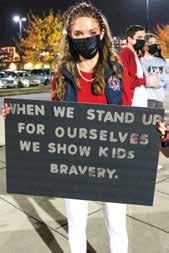
Union membership and contract negotiation are the only ways to address unreasonable additional duties. While some labor movements have cost employees their lives,
teachers around the commonwealth sacrifice around $30 a paycheck for their union dues; education support profes sionals, about $17 per paycheck.
Yes, times are hard; yes, we’re already underpaid. Union membership, though, is a financial investment that will pay tremendous dividends.
Look past the insurance perks, the travel deals, the free and worthwhile professional development, and look at the long term: that $17 to $30 a paycheck will show our school divisions that we’re not only organizing among ourselves, but that local chapters are also collaborating across Virginia. We will reap the benefits of organizing every day by lifting ourselves up together.
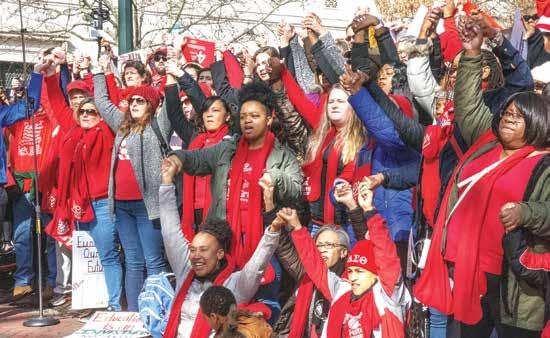
Contract negotiation will make Virginia school sys tems an appealing place to work. In a few years, students’ lessons on the educators’ labor movement of 2022 will be enhanced because their teachers won’t be frantically
overburdened, ESPs won’t be worrying about getting to their second jobs on time, and a fully staffed custodial team won’t be struggling to keep their schools clean.
Today’s union membership and contract negotiations will provide tomorrow’s students the opportunity to learn in such an improved environment. When we organize through VEA, Virginia’s educators will show the Common wealth that we truly are in it for the outcome.l
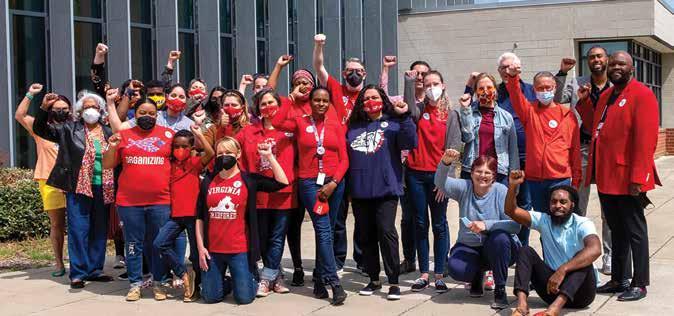
18 VIRGINIA JOURNAL OF EDUCATION | NOVEMBER 2022 VIRGINIA JOURNAL OF EDUCATION NOVEMBER 2022 19 Photos by Olivia Geho FEATURE STORY
Jennifer Naperala, a member of the Chesapeake Education Association, is an English teacher at Hickory High School.
A Chesapeake teacher explains why unity and collective bargaining benefit everyone.
VEA’s First-Ever EPIC Conference
Inspires, Encourages Educators
Sure, there were tons of great informa tion and best practices shared at VEA’s inaugural EPIC Conference this weekend, but they almost seemed secondary to the emotional high many attendees took home with them.
No one helped create that high more than keynote speaker Dr. Manny Scott, one of the original Freedom Writers upon whom the Hollywood movie was based. He riveted the crowd with tales from his brutally difficult childhood in Los Ange les and the lifesaving, trajectory-altering influence educators had on him.

Urging attendees to do the same for their students, he told them, “The fact that you’re still here in this difficult climate tells me that you know life at its best is not about the money you make, the degrees you have on the wall, or the great things you accumulate—it’s about service, loving and helping people. You have extraordi nary hearts. Never, never underestimate the power of your voice!”
VEA’s current Education Support Pro fessional of the Year, teaching assistant Ar thur Anderson of Chesapeake, was bowled over. “Dr. Scott spoke to my soul,” he said during his own speech, adding, “Every day, we have the opportunity to encourage, to inspire students to do better, to tell them what their purpose is.”

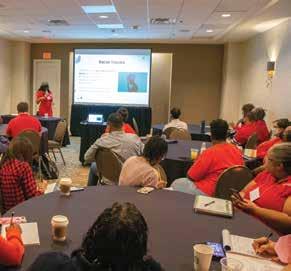
In addition to the inspirational large-group sessions, EPIC attendees also had options during three breakout blocks, tackling topics in smaller groups.

EPIC (Education Professionals In Collaboration) is a new event bringing together the Instruction and Professional Development and Education Support Professionals conferences and the Teachers of Color Summit.l
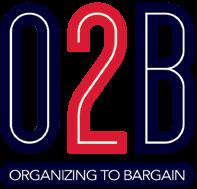
ESP
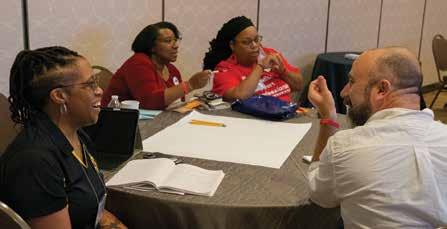
Bargaining Activities Percolating as Organizing Continues
Union members around Virginia are continuing to make progress under the state’s new bargaining law. Here’s a sampling of what’s been happening:
• Richmond Education Association members in the four approved bargaining units have had their first session at the table, submitting proposals on everything from instructional issues to salary scales. Three other bargaining units in the city are getting closer to the percentage of signatures needed to move the process forward to card checking and elections.

• Arlington Education Association members, with the help of NEA staff and a group of volunteer UniServ Directors, held a card campaign blitz and are moving ahead with their collective bargaining campaign.
• In Alexandria, on the strength of a very successful fall membership drive, Education Association of Alexandria members have a card campaign underway. They also have the assistance of one full-time organizer.
• Member of the Falls Church City Education Association are also engaged in a card campaign and are close enough to the number of signatures needed to begin planning to petition their school board to begin the bargaining process.
• In Prince William, the county’s school board is working on a collective bargaining resolution with the help of Prince William Education Association members.
• Bus drivers in the Lynchburg Education Association continue to petition for a collective bargaining resolution from the city’s school board, not backing down after the board voted against an earlier one.l
NEA Resources for Professional Growth and Learning

Your nationwide Union, the National Education Association, is an excellent source of professional learning for educators working in just about any setting. And you know it’s great information, because it’s been created by NEA members for their colleagues. Here’s a sample of what’s available:
• Teacher Professional Growth, to offer the kind of ongoing informa tion you’ll need to stay at the top of your game throughout your classroom career.
• ESP Professional Growth because to provide the best public schools we can, our ESPs need high-quality professional development and support.
• Professional Learning Resources including workshops, webinars and other opportunities for continuous growth and improvement.
To learn more about how you can take advantage of these and other NEA-created resources, visit nea.org/ professional-excellence/professional-learning.l
VIRGINIA JOURNAL OF EDUCATION | NOVEMBER 2022 21 MEMBERSHIP MATTERS
20 VIRGINIA JOURNAL OF EDUCATION | NOVEMBER 2022
UPDATEPhotos by Lisa Sale
Dr. Manny Scott, top left.
President Fedderman opening the conference, top right. EPIC participants in breakout sessions, middle and bottom right. VEA
of the Year Arthur Anderson, above.
Know an Outstanding Retired Educator?

VEA honors a member of VEA-Retired each year with the Martha Wood Distinguished Service Award, which is named for one of VEAR’s founding members and its first president. If you’re either an active or retired member and know a VEA-R member whose hard work and dedi cation to public education and to our Union deserves to be recognized and appreciated, contact Bea Snidow at bsnidow@veanea.org for nomination directions.l
Want to Boost Your VRS Life Insurance?
You Can Do So Until Nov. 30
Knowing your fami ly has the resources they’ll need means peace of mind for when you’re no lon ger there to support them. As a full-time teacher or admin istrator, you’ve got basic group life insurance through the VRS Group Life Insurance Program from your first day on the job. And right now, Securian Financial, the insurer, is offering an opportunity to add to your insurance protection without medical underwriting during a special enrollment window that lasts until November 30.
Several options are available for active VRS members:
• You can enroll in the Optional Group Life Insurance Program for the first time for additional coverage equal to 1x your creditable compensation.

Allen Joins VEA Legal Staff
Moriah Berger
Allen has joined VEA as a staff attorney in the Legal Advocacy department. After earning her law degree at North eastern University School of Law, she’s worked with a public sector education union of the CUNY, a field attorney for the National Labor Relations Board in New York City, and as Assistant Dean in the Office of Career Services at the William & Mary Law School.l
• If you already have Optional Group Life coverage at 1x, 2x or 3x your creditable compensation, you can increase coverage by one coverage level, not to exceed 4x your creditable compensation, or $400,000.
If you were previously denied coverage due to medical underwriting, you will be able to take advantage of this one-time opportunity to apply without proof of good health.
To take advantage, you can apply by answering three questions about your health history—along with your height and weight. Coverage options are available up to 8x your creditable compensation, with an $800,000 maximum. You may also purchase coverage for your spouse or dependent children, though they will need evidence of insurability (proof of good health) unless applying within 31 days of a qualifying event, such as marriage or the birth or adoption of a child.

For details, visit varetire.org/life-insurance and select Optional Group Life Insur ance Program Features.
Enrollment is easy by logging into your myVRS account at myVRS.varetire.org
Select Life Insurance under the My History tab and then the Visit Securian button.

Simple enrollment takes just a few minutes.
To stay up to date on the latest VRS news and information, follow the Virginia Retirement System on Facebook and subscribe to Member News at varetire.org/ newsletter.l
PRESIDENT’S MESSAGE
It’s Not Too Early to Gear Up for the General Assembly
— Dr. James J. Fedderman
With the focus on Congressional and local elections this fall, Virginia voters won’t be making any significant changes to the General Assembly’s lineup. In some years, that might be good news for public education supporters, but this year it means we’ve got some work to do. All of us.
There will be a lot at stake for our students and us when our legislators convene in January, and we’ll have to be prepared to be on both offense and de fense. And we must, because when our members’ voices are heard in Richmond, we make things happen!
On offense, we think it’s long past time that our legislature do something that’s been right in front of them for years—fully fund the Standards of Quality as the Virginia Board of Educa tion has defined them. SOQs are really just a minimum goal for what our public schools should be providing, yet the General Assembly lets session after session go by without finding the money to support them. This inaction solves nothing, and shifts financial burdens to localities, many of which are not able to handle them.
We fought long and hard to earn the right to collectively bargain con tracts and we’ll fight on to keep—and strengthen—those rights. Legislation came up last year that attempted to curtail some of them, and we helped kill it. If we have to, we’ll do so again this
year. Bargaining rights must grow, not shrink. Negotiating with school divisions is one of the best methods we have to address issues and implement solutions that are best for our students, educators, and communities.
Our members will also be letting their representatives know how import ant it is to step up in areas like English Language Learner services, support for teachers in pursuit of National Board Certification, and community school models.
We’ll be fighting for justice, too, as educators always do. We’ll speak out for schools that welcome all children and discriminate against none. We’ll advocate for safe school environments to protect students and staff, supporting measures for healthy indoor air quality, common-sense gun laws, and reducing child poverty.
When we must turn to defense, it will be to beat back ill-conceived efforts like diverting public money to private schools, arming any school personnel, reducing retirement or health benefits for school employees, and laying any unfunded mandates on our schools.
Only our collective voice is strong enough to make some of these things happen and prevent others. All of us must stand up and speak up for our students and each other. Stay tuned—in the weeks ahead, we’ll help you do just that. It matters for all of us.l


Spotsy’s Parker Named Virginia’s Teacher of the Year
Spotsylvania Education Association member
Fabiana Parke an English as a Second Language teacher at Thornburg Middle School and a former ESL student herself, has been named Virginia’s 2023 Teacher of the Year.
An educator since 2003 and a Spotsylvania teacher since 2021, Parker grew up in Brazil and launched her career as a teacher as a 10-yearold, teaching her grandmother to read.
Later, she studied education and languag es at Kings College in London and also earned a master’s degree in education, curriculum and instruction from Boise State University.
“I would like to thank my school, my principal, and especially my students,” Parker said after receiving the Teacher of the Year honor. “I do this for them.“
She’s also an active community volunteer and has worked at an animal-rescue center and as a medical interpreter and COVID-19 contact tracer for the Virginia Department of Health. Parker will go on to represent Virginia in the Council of Chief State School Officer’s National Teacher of the Year Program.
She was chosen from among the 2023 Regional Teachers of the Year, who included:
• Jordan M. Markwood, a Loudoun Education Association members and music teacher at Rock Ridge High School.
• Lori C. Peltonen a Staunton Education Association member and library and media specialist at Staunton High School.
• Kiara S. Thompson a Richmond Educa tion Association member and physical science teacher at Thomas C. Boushall Middle School.l
VIRGINIA JOURNAL OF EDUCATION NOVEMBER 2022 23 KUD S
MEMBERSHIP MATTERS
22 VIRGINIA JOURNAL OF EDUCATION | NOVEMBER 2022
Photo page 22 by iStock
Flipping the Script
Discussion prompts created for teachers, not students.
Teachers spend a lot of time thinking about and creat ing discussion prompts for their students, and are often rewarded with excellent classroom participation and feedback. As a change of pace, here are prompts designed for teachers, to help them reflect and grow in their work, courtesy of TeachThought.com. We hope they’ll be great fodder for lots of constructive thinking and sharing, and for becoming even better at what we do.
• What are the best parts of being a teacher?
• What is one small delight in the day that you always look forward to?
• What are you most proud of to date in your teaching career?
• What part of teaching is better than you thought it would be?
• How have you grown as a person since becoming a teacher?
• What was the nicest thing a student or colleague has ever done for you?
• What are your strengths as a teacher? Which are you most grateful for?
• Share a quote about teaching or quote about learning that has inspired you.

• What new learning has inspired you in your career?
• Write about a memorable moment in the classroom and how it reminded you about why you love what you do.
• What was your mindset when you became a teacher? What is it now? How has it changed and why?
• Share a recent time you laughed in your classroom as a teacher and what it taught you about teaching or learning.
• What is the most important ‘lesson’ you want to teach your students?
• Share a photo (or photos) of things and/or people you are grateful for in your personal life.
• What are three things you are grateful to have learned in your teaching career?
• What technology tools are you most grateful for? Why? How have they changed what you do?
• What is the most powerful aspect of being a connected educator? What are you grateful for?
• One thing that is different from a year ago that I am grateful for…
• What do you appreciate about your colleagues? How do you support one another–maybe in less obvious ways?
• Tell someone you know how grateful you are for the work they do. Share your story on social media or with colleagues or your family and friends.
• What is one lesson as a teacher you are thankful for having learned?
• Identify a book about teaching that you are thankful to have read and how it has inspired you to be better at what you do
• What traditions exist in your school or school community that you are most grateful for?
• What are your dreams for education in the future?
• What part of teaching would you like to let go of, that no longer serves you or could be better done in other ways?
• What’s the most important ‘thing’ you’ve ever done as a teacher? What makes it the most important thing?
• If you could bottle up the perfect day as a teacher, what would it look like?
• Talk about one opportunity as an education professional that you are grateful in hindsight for having passed you by.
• We all know someone who inspires us to be better. Share who that person is or has been.l
The Help Our Kids Need the Most
According to the Virginia Depart ment of Educa tion, these are 2020-21’s 10 most critical shortage teaching endorsement areas in Virginia:
1. Special Education
2. Elementary Education PreK-6

3. Middle Education Grades 6-8
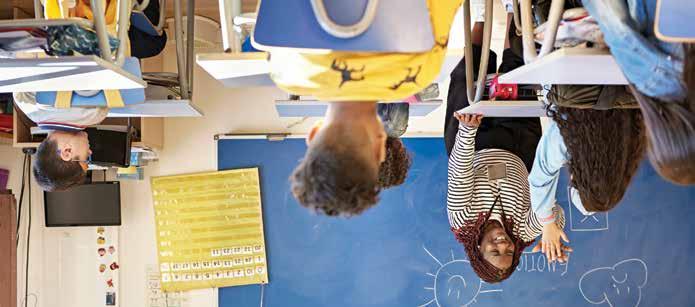
4. Mathematics Grades 6-12 (including Algebra 1)
5. Career and Technical Education
6. Science (Secondary)

7. Foreign Language PreK-12
8. English (Secondary)
9. Library Media PreK-12
10. History and Social Science (Secondary)l
Source: VDOE report “2021 Annual Report on the Condition and Needs of Public Schools in Virginia”
It Can’t be Done
“One person trying to meet the needs of 500 students? It’s impossible.” l
Jan Desmarais-Morse, an Indiana school counselor, on the fact that two counselors at her school are splitting 1,000 students. The American School Coun selor Association recommends a ratio of 250 students per school counselor, a goal very few states achieve. Virginia’s ratio, according to the ASCA, is 1:318.
VIRGINIA JOURNAL OF EDUCATION | NOVEMBER 2022 25 Photos and illustration by iStock 24 VIRGINIA JOURNAL OF EDUCATION | NOVEMBER 2022 INSIGHT ON INSTRUCTION
Education Leaders Weigh In on Our Teacher Shortage


“What we have now is a number of significant barriers to entering a profession that is very challenging…How do we make this job as attractive as possible to high-abil ity people? That requires looking at financial barriers to entry. Can we reasonable expect someone to take out $50,000 in loans for a job that pays $40,000? Can we reasonably expect somebody to take on this job who has not been trained in mental health when we know that some significant percentage of their students are going to require mental health support and their school will likely not have a nurse, counselor, or a school psychologist?”
— Christopher Morphew, dean of the Johns Hopkins University School of Education

“Here’s what we know: When we listen to, respect and support educators, students win. We must act now to implement long-term solutions to attract and retain diverse and qualified educators.
The solutions are clear. We need to pay professional wages, create supportive and respectful workplaces, and trust educators to do their jobs. We need to inspire educators through mentoring and support so that they can inspire students. The problems we face are not insurmountable. We know that supporting educators and providing our schools with the resources students need to succeed is the not-so-secret sauce.”
— NEA President Becky Pringle
“Unless we’re serious about providing competitive salaries for our educators, better working conditions, so that they can continue to grow ... we’re going to constantly deal with shortage issues, especially in our areas that are harder to teach or where there are less candidates. But also, I think it’d be short-sighted for me to talk about this without acknowledging that we have a teacher respect issue in this country, too.”
— U.S. Secretary of Education Miguel Cardona
“Making certification easier could help. It takes five years to earn a bachelor’s in education degree with certification at many colleges and universities. Education majors graduate with an extra year of debt that qualifies them for a profession in which they will be underpaid…Some requirements should be modified or eliminated. Student teaching could be replaced with a paid apprenticeship under the guidance of an experienced teacher.”
— Tom Mockaitis, professor, DePaul University
“Increase teachers’ salaries so much that they would be willing to deal with all the problems of teaching. Pay them so much that school districts attract the best and most gifted teachers who could work elsewhere and get paid what they are worth. And don’t provide just workshops; instead, provide skilled teachers who will work for at least one hour a day with every new or beginning teacher, as well as with any teacher, regardless of experience, who needs help.”

Diana Wolff, professor emerita of education at Cal State Dominguez Hills l

Help Your Students Understand the Vietnam Wa r
The U.S. Vietnam War Commemora tion provides a collection of classroom resources addressing a variety of topics about the war American forces fought in Vietnam for more than a decade. Developed by historians and educators for middle and high school students, the materials include artifacts, videos, maps, posters, and a Teacher Toolkit, which of fers websites, activities, books and other resources.
Learn more at vietnamwar50th. com/history_and_legacy/educator_ resources l
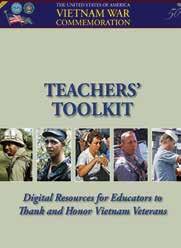
26 VIRGINIA JOURNAL OF EDUCATION | NOVEMBER 2022 INSIGHT ON INSTRUCTION Photo-illustration page 26 by Stephen Gwaltney
VIRGINIA JOURNAL OF EDUCATION | NOVEMBER 2022 27


What Being the ‘Dumbest Kid in the Class’ Taught Me
That day, the first of second semester of my sophomore year in high school, remains one of the most humiliating things that has ever hap pened to me. My geometry teacher called me to her desk and, in a voice I thought was loud enough for everyone in class to hear, told me that my 35 average for the first semester made it mathematically impossible for me to pass for the year. Consequently, she had already arranged with guidance for me to be removed from her class and exiled to study hall. I could retake geometry in summer school, she added.
That January 1968 day remains a major influence on how I teach.
In ninth grade, I’d earned a low D for Algebra I, causing a trip to summer school for remediation. It didn’t help, nor did the succession of math tutors my parents hired. Wretched and hating all things math, I settled miserably into my role as the dumbest kid in class, a position I continued to hold through 11th-grade Algebra II and senior year’s Math Survey. The guidance department had sagely deduced that Calculus and Trigonometry were well beyond my skills.
Today, every time I sense that one of my high school English students is struggling mightily in one of my classes or tells me that he or she is, flash back to my geometry classroom and question whether I’m doing enough to reach those individuals who feel or fear they’re “the dumbest kid in class.”
One of the positives that many teachers possess is that they are very intelligent people who did extremely well in school. But knowl edge so easily gained can also be a detriment if we fail to consider that some young people, through no fault of their own, are sometimes overwhelmed by concepts we had no difficulty mastering. And what’s even worse, harsh, unthinking words from teachers (like those from my geometry teacher) can continue to negatively impact students for years to come. Conversely, positive words, like my 10th-grade history teacher, Mrs. Ergle, telling me I was a good writer, can have long-term positive
repercussions.
To this day, all things math terrify me. For example, several years ago during a workday at Lord Botetourt, teachers were divided into groups with each individual in every group given an envelope with math-based puzzles to solve – which would lead to the group as a whole solving a later puzzle. The facilitator then orally gave four steps on how to solve the individual and group puzzles.

All my life, I’ve also had difficulty following oral directions if they consist of more than three steps. Making me stress even more, the facilitator announced a time limit for the game. By the time I opened the envelope with what was to me impossi ble-to-solve math puzzles, my panic-stricken self had forgotten what the first step of the process was, and I had once again become the dumbest kid in class.
Then, kindly, two members of my group, admin istrator Debbie Harris and biology teacher Julie Foltz, demonstrated what good teaching really is. Sensing my confusion, one of them slowly repeated the directions while the other patiently helped me with the math problems. With their help, I could feel the anxiety slowly fading, and I completed the task.
At my school, we’re on a system where students do a year’s worth of work in a semester. First semester last year, ran into a student who had made a C in my English 9 General class the year before. That year, I had always thought she had the potential to be a strong writer, but her lack of self-confidence and poor English grades over the years had caused her to hate the subject.
I tried to talk the girl into taking my English 10 Honors class second semester, and was finally able to do so. More than once second semester, she told me she felt like the dumbest kid in my class, but I kept encouraging her and helping her with her writing. Slowly but steadily her writing and confidence im proved, and she ended up with an A- average for the year.
On the last day of school, told her how proud was of her and she gave me the biggest smile –mo ments we teachers live for.
Who knows? She might grow up to become a teacher. I know the dumbest kid in a high school geometry class did.l

30 VIRGINIA JOURNAL OF EDUCATION | NOVEMBER 2022
FIRST PERSON: NARRATIVES FROM THE CLASSROOM
Bruce Ingram, a member of the Botetourt Education Association and a veteran educator, teaches English and Creative Writing at Lord Botetourt High School. He’s our new “First Person” columnist and can be reached at bruceingramoutdoors@gmail.com.
— Bruce Ingram Illustration by iStock
A publication of the Virginia Education Association 116 South Third Street, Richmond VA 23219 veanea.org vea4Kids






MASTER OF ARTS IN TEACHING AND LEARNING, where teaching practice, collaborative curriculum development, and building leadership skills are emphasized.
MASTER OF ARTS IN LIBERAL STUDIES, which encourages creating your own graduate degree to fit your needs.
For those teachers who already have a master’s degree, 18 GRADUATE HOURS in English, mathematics, or history qualify you to teach dual enrollment.
CONTACT US to learn more about how we can help you become an extraordinary PK-12 teacher. (540) 362-6575, hugrad@hollins.edu, or visit hollins.edu/grad
Take your teaching
to the next level At Hollins University, our coed, online graduate programs for licensed teachers are designed to challenge and inspire while offering the flexibility necessary for busy schedules.
skills



























 By Nathan Sekinger
By Nathan Sekinger



































